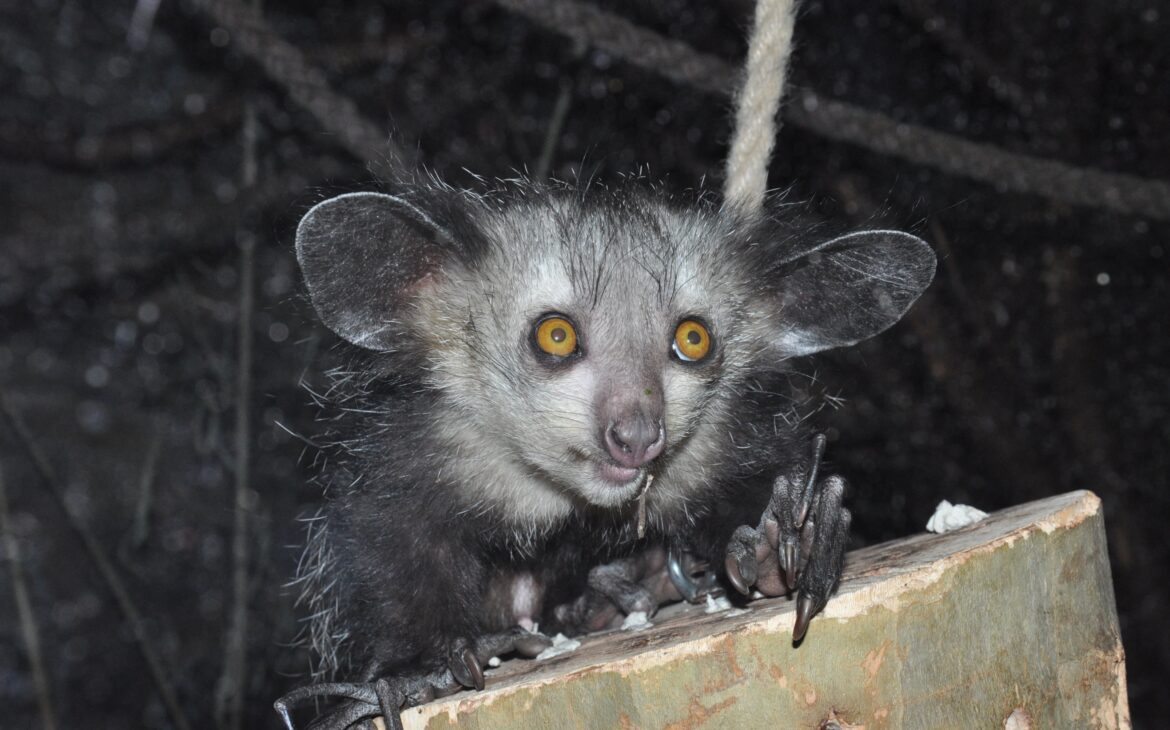By Kayla Pringle
The aye-aye is an extremely unique and mysterious animal because it is not like any other primate in the world today. This is largely due to the fact that it is the only primate to exist within its family, Daubentoniidae, while the rest of the species in this family has gone extinct.
The aye-aye is endemic to Madagascar and is primarily arboreal, nocturnal, and solitary. They are typically 40 cm long with a 22 cm tail. They have rough fur that is dark brown or black in color, a short face, large eyes, and continuously growing front teeth similar to those of rodents. Sounds creepy right? I actually think they’re so ugly that they’re kind of cute.
Now it’s time to reveal the aye-aye’s most unique trait. They are known for their elongated, thin, middle finger. They have 5 fingers on each hand like any other primate, but the third digit is elongated. This elongated digit has sensory abilities, and they use it by tapping on trees to find the location of grubs and other insects.
Once this digit detects food, they will use their rodent-like teeth to gnaw into the wood to create a hole. After the hole is created, they will use their long finger to extract any grubs or insects are inside. This method of foraging is called “percussive foraging.” There are very few mammals who can find food this way. Aside from the aye-aye, the only animals known to forage this way include the striped possums from Australia and New Guinea.
Remarkably, this finger can even reach through a nostril into the throat and is used for nose-picking and consuming mucus gathered from inside. Wait, did I really just say that? Additionally, the aye-aye has developed a unique sixth digit, known as a pseudo thumb, which enhances its ability to grip.
In North America, woodpeckers play a crucial role in ecosystems by creating tree cavities that many animals rely on. However, in Madagascar, where woodpeckers are absent, the aye-aye fills this vital ecological niche. Tree cavities are essential for the survival of numerous species, making the aye-aye a key contributor to Madagascar’s unique ecosystem.
The aye-aye is considered Endangered, according to the IUCN Redlist. Some of the major threats to their existence are habitat loss and illegal hunting. Their population levels declined so much that they are now protected by law. Deforestation and habitat loss due to agriculture, logging, and forest fires are another main cause of decline.
Even though aye-ayes can look a little creepy, they are extremely important to their ecosystem. They are unique animals that deserves to exist, and I hope to see their population levels increase in the future. So, how can we help if we’re hallway across the world from the aye-aye?
The best way to help these animals while being so far away is by educating people. Aye-ayes aren’t well known because they’re so rare and many zoos don’t have access to them. Educating people is always the first step. Thanks for reading, I hope you can learn to appreciate these creepy little critters.
Photo caption: An aye-aye at the Frankfurt Zoo
Photo credit: Elias Neideck, CC BY-SA 4.0 <https://creativecommons.org/licenses/by-sa/4.0>, via Wikimedia Commons

